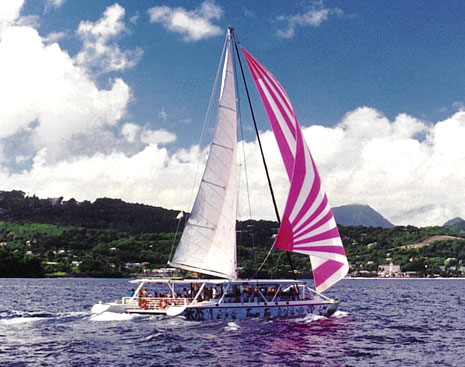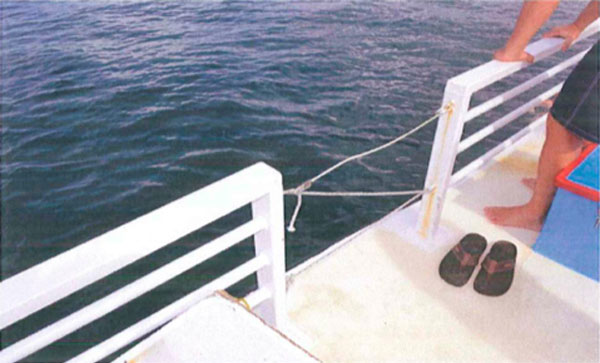Meyer v. Carnival: Randall Jaques Affidavit / Tour Inspector
This affidavit and deposition is part of our much larger coverage of the Michael Meyer v. Carnival Cruise Lines et al. case resulting from a catamaran propeller accident on a cruise ship shore excursion.
Randall Jaques, a marine safety and security consultant, was hired by plaintiff’s counsel to review events leading up to the accident, to inspect the vessel, to review the depositions, and to take a tour on Cox’s Catamaran Cruise to the Pitons, to review the practices and procedures of Carnival, Cox, Sea Spray, and the crew of the M/V Tango Too, and to determine was caused the event and Mr. Meyers injuries.
Randall Jaques filed an affidavit of his findings. The affidavit was notarized 26 April 2013.
Most of our coverage of these affidavits and depositions comes from legal documents in PACER (Public Access to Court Electronic Records). We encourage those who wish to study the case more in depth to establish a PACER account and view the original records. Fees are typically about a dime a page.
Randall Jaques Affidavit
Jaques previously worked for as a security chief on several vessels for Carnival, had been responsible for supervising tender operations in ports with no cruise ship docks, had been a security chief for vessels of other cruise lines, had occasionally monitored safety on Carnival sponsored shore excursions, and worked numerous military assignments.
He booked a 19 January 2012 tour on the Tango Too that was primarily for passengers on a Royal Caribbean cruise ship docked in Castries. Jaques had no problem booking tickets directly with Cox.
He viewed the vessel’s Small Craft Certificate in St. Lucia. M/V Tango Too is owned by Sea Spray Cruises, is 80 feet long, displaces 56 tons, has a maximum draft of 5.5 feet, and is licensed to carry up to 150 passengers.
His tour boarded about 9 am near the Royal Caribbean cruise ship. it had four male crew members and about 30 to 40 passengers.
Near the beginning of the voyage, the Senior Host gave a talk which Randall videotaped. The host talked about how to wear a life jacket, how to flush the toilets, when alcohol would could be drank, and told them they would be stopping for a swim before reaching the Pitons. The host told weak swimmers they should use life jackets.
The vessel motored into a bay, stopped short of the beach, cut the engines, and was secured. The crew lowered the front ramp but gave no guidance as to when passengers could enter the water from the front or stern. When the vessel reached the swimming stop, there was no “briefing” or mention of safety rules regarding the swimming stop.
A crew member occasionally offered life jackets to those exiting the front, but no one did the same at the aft end.
Several passengers including Randall that had been near the stern jumped over the side near the stern. The crew did not protest and offered them no guidance.
Jaques estimated it was about 3 feet from the surface of the water to port propeller. He saw nothing else in that area of the vessel capable of cutting a swimmer.
Jaques noted when the vessel is stationary and the engines are running, there is very little engine noise, and no visible prop wash even with the props engaged.
After about thirty minutes the crew asked the remaining swimmers to come back aboard, raised the ramp, and closed the portals at the stern.
Randall summarized the excursion as a party cruise with swimming, snorkeling, a little food, and large amounts of alcohol. He noticed some of the crew members were drinking as well.
Jaques then reviewed Cox’s depostion, Michael Meyer’s deposition, and Carnival’s deposition.
Next, Jaques discusses Dangers of Small Vessel Operations and Necessary Standards of Marine Behavior.
Jaques noted safety was increasingly important when operating in remote areas far from medical care as was this instance.
He submitted the USCG online circular titled “Propeller Injury Awareness”.
Jaques then submits the U.S. Coast Guard “Beware Boat Propellers: A Hidden Danger” circular. PGIC comment – we reviewed this publication prior to publication and USCG included some of our comments/suggestions in its final form.
Jaques talks about some of his experiences at Carnival. He learned the only way to assure passenger safety was to:
- Have uniform specific standards of behavior (preferably in writing)
- Communicate those standards to those expected to execute them
- Follow up with periodic announced and unannounced inspections
- Incentivize compliance (by punitive measures if necessary)
Jaques was repeatedly reminded by Carnival and other cruise lines that failing to apply this process “was a recipe for disaster and would lead to injuries and deaths, or such “accidents waiting to happen.” (pg.15).
When Jaques worked at Carnival, Carnival knew there was no reason to assume local Caribbean tour operators left to their own devices would uniformly and reliably live up to the necessary standards of care. Most Caribbean governments have only rudimentary regulatory and enforcement infrastructures, St. Lucia is not an exception. Jaques is familiar with several mishaps to Carnival passengers on tours by contracted small vessel operators, including Cox.
Carnival has been sued for unsafe catamaran operations associated with Cox in this same court before (Henderson case).
Carnival’s contract with Cox talks about maintaining “highest standards of quality in the industry”, “professional manner”, “generally accepted industry practices”, and “reasonable care for Excursion guests’ safety” but fails to elaborate upon or define those behaviors.
Carnival does its inspecting by monitoring passenger complaints. Passengers are not experts in maritime safety. (pg.18).
Carnival tolerates subcontracting although it is expressly forbidden in their excursion agreement with Cox.
SeaSpray’s insurance was through a Caribbean insurance company which is against Carnival policy, in addition to being insufficient in coverage. (pg.19).
Cox says that prior to the Meyer incident they had an unwritten agreement that swimmers were not to be allowed in the water before the catamaran’s engine and propellers were deactivated AND the crew was to communicate in two separate safety briefings that they were not to enter the water prior to a signal from the captain. Those procedures were still not being followed when Jaques rode the same vessel in January 2012. In that ride he did not even see the previously described regular female Cox representative.
On his inspection ride, instead of keeping the passengers under close observation, the crew appeared to be schmoozing individual passengers to troll for tips.
It appears the female Cox representative was the one that gave the go ahead for passengers to enter the water before the propellers were disengaged on the day of the Cox incident.
Jaques has seen other rotating propeller injuries. The photos of Meyer’s leg injuries are consistent with them, along with his inspection of the vessel finding no other hardware capable of causing such injuries in that area. For the propellers to suck Meyer in as Meyer describes, they would have had to have been engaged. Therefore Jaques finds Meyer’s injuries were caused by him being drawn into the engaged propellers which the crew failed to dis-engage before allowing him and other passengers to enter the water.
Carnival failed to insure a standard of performance by providing specific instructions regarding desired behaviors following up with personal inspections, and establishing a credible threat of sanctions for failure to perform.
Jaques attached documents include a copy of the Standard Shore Excursion Independent Contractor Agreement made with Cox 1 May 2003 to which addendums were later added. He also includes a copy of Cox’s Water Craft Standards/Policy, the two U.S. Coast Guard propeller documents mentioned earlier, and a Westlaw brief on the Jennifer & Joseph Henderson v. Carnival Corporation case involving a catamaran on a Cox excursion in St. Lucia.
Randall Jaques Deposition
At a later date, Randall Jaques’ deposition was taken. Noah Silverman (for Cox) beat him up for not being an expert in many fields (human factors, Mechanical Engineering, Tides, Underwater Topography, Currents, or operating catamarans). Opposing sides often bash the other experts for not being experts in many fields. Silverman later (Jaques deposition pg. 221) added medicine and biomechanics to the list. Silverman also attacked Jaques for not identifying any relevant St. Lucia laws, policies, and procedures applying to the catamaran.
Jaques went on his inspection tour with Michael Eriksen (Plaintiff attorney) and Brock Ohlson (Plaintiff attorney).
Silverman made a big deal about the inspection voyage swim stop being at a different site than the one used in the Meyer voyage.
Silverman started badgering Jaques about where people could get one the USCG propeller safety flyers. Jaques noted USCG made a graphic commercial and pulled it down because it was too graphic (PGIC comment – a reference to USCG’s “Don’t Wreck Your Summer” Public Service Announcement.)
Silverman asked him if he was rendering any opinions about Cox or Sea Spray being aware of any similar incidents. Jaques mentioned the other case with a Cox catamaran injury from striking a reef. Silverman said they were not struck by the propeller of the Tango Too. For Silverman to consider it a similar accident, it had to be a prop strike on the Tango Too.


Very interesting way of describing the case. Sorry all the details and the outcome were not published. Silverman who beat me up, was subsequently beaten up in federal court and settled for a huge award before it went to the jury.
At one point in my deposition that was taken!, the defense insinuated and kept demanding the long gashes on Mr. Meyers body were from barnacles under the cat. Sure!
Thanks to Mr Jaques, an expert witness for the injured party (Plaintiff), for sharing his insights on the case. If anybody needs similar services in the future surrounding propeller injuries on larger vessels or shore excursions, he can be reached at Randall W. Jaques Maritime Safety Consultant and Expert Witness.